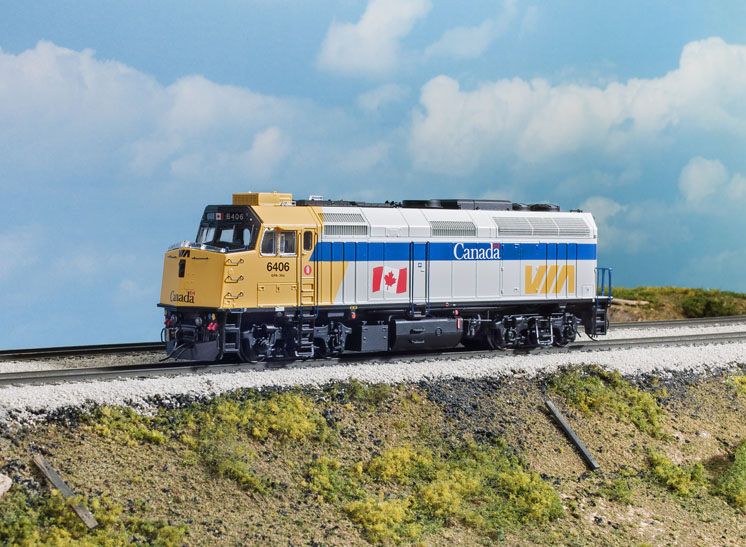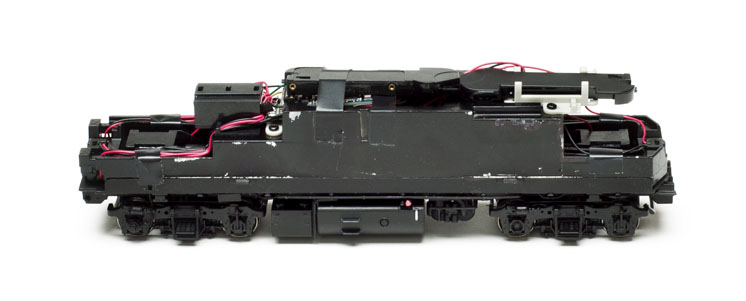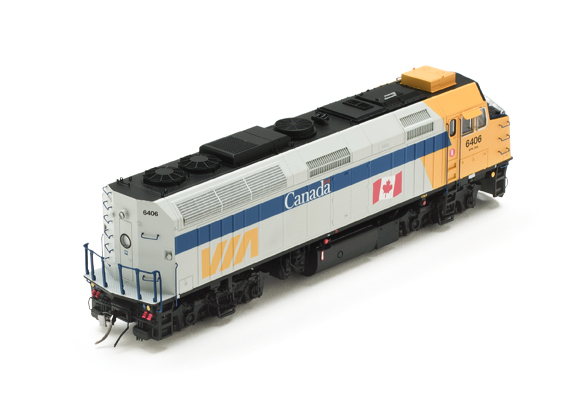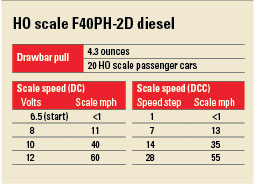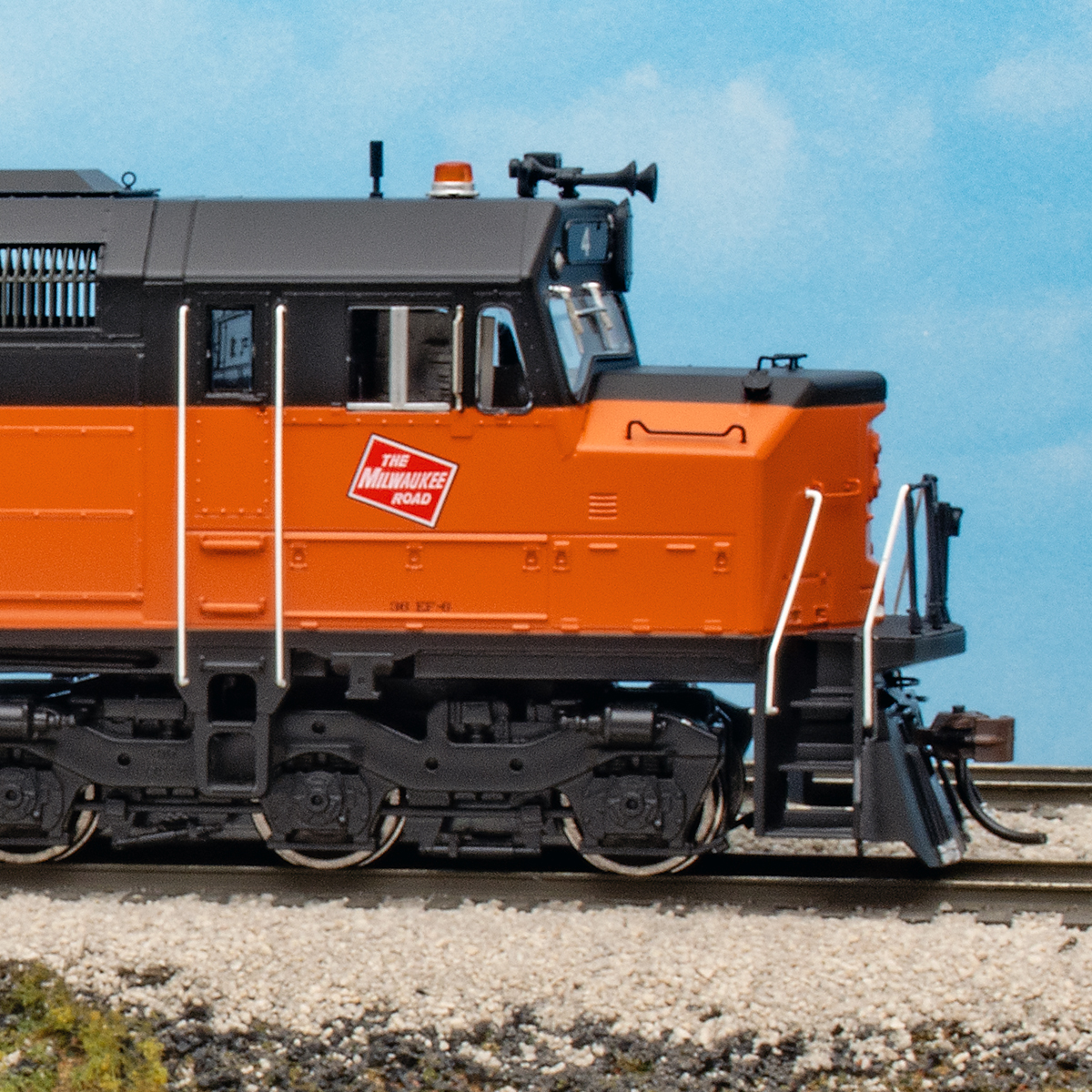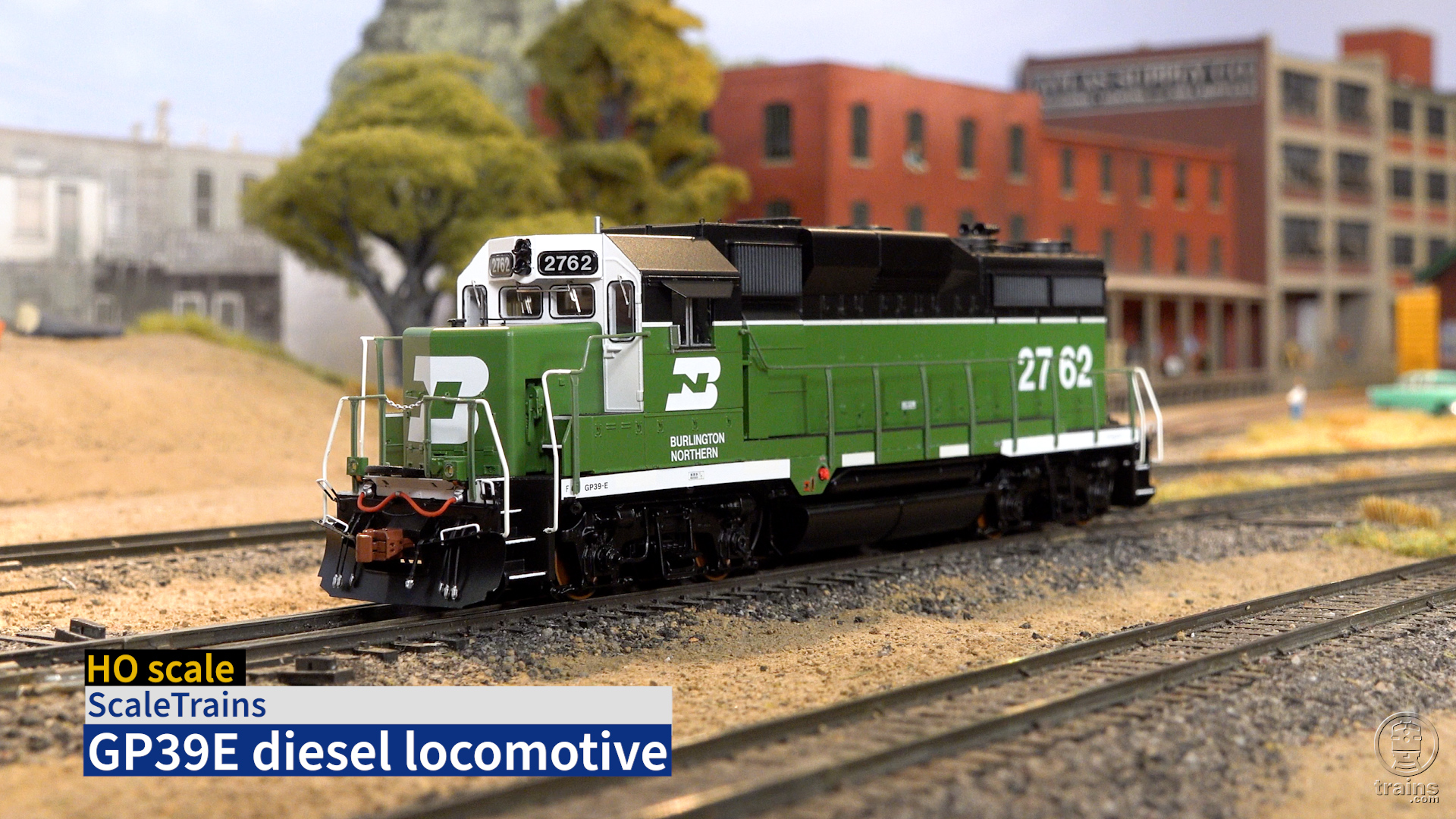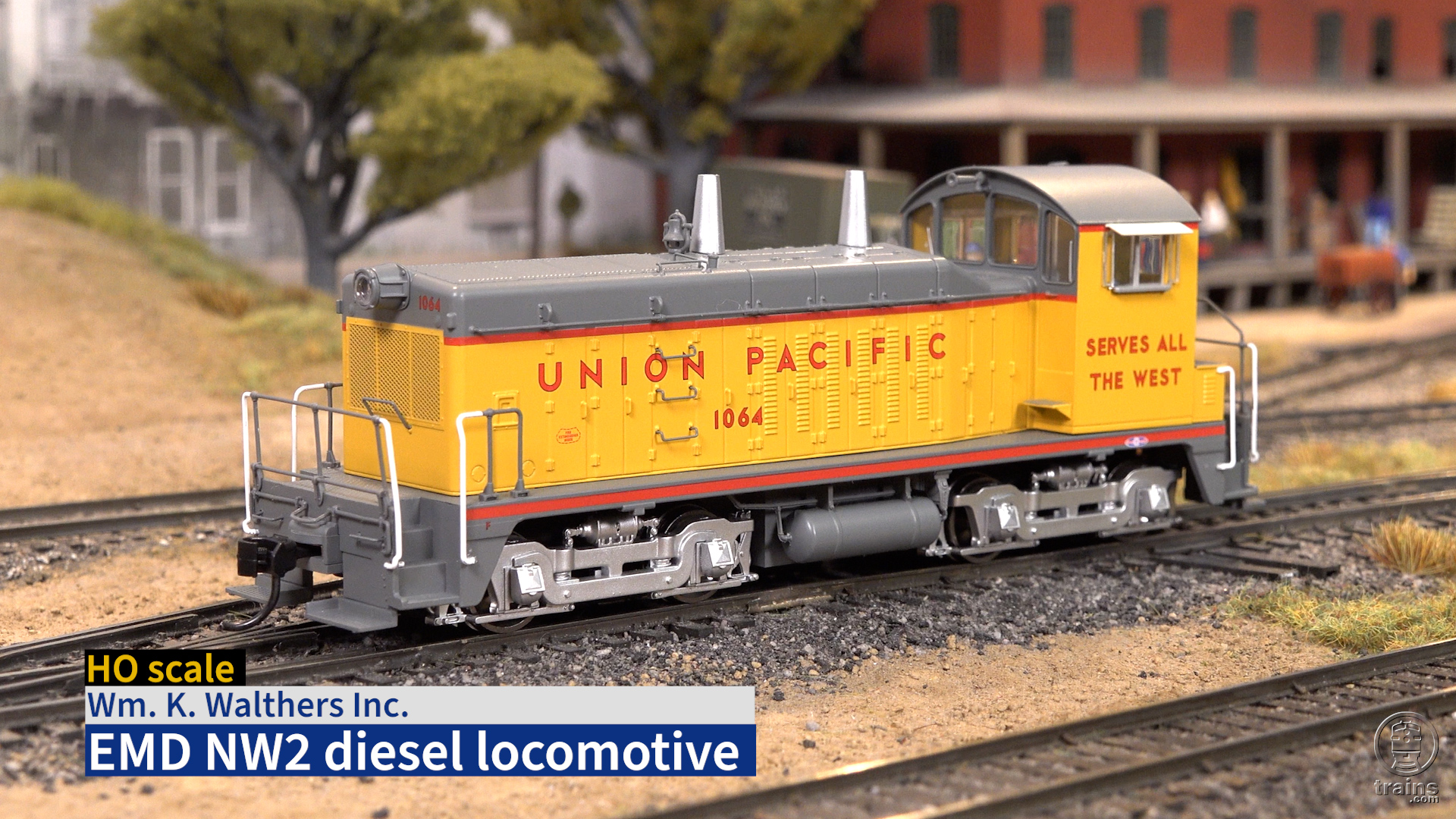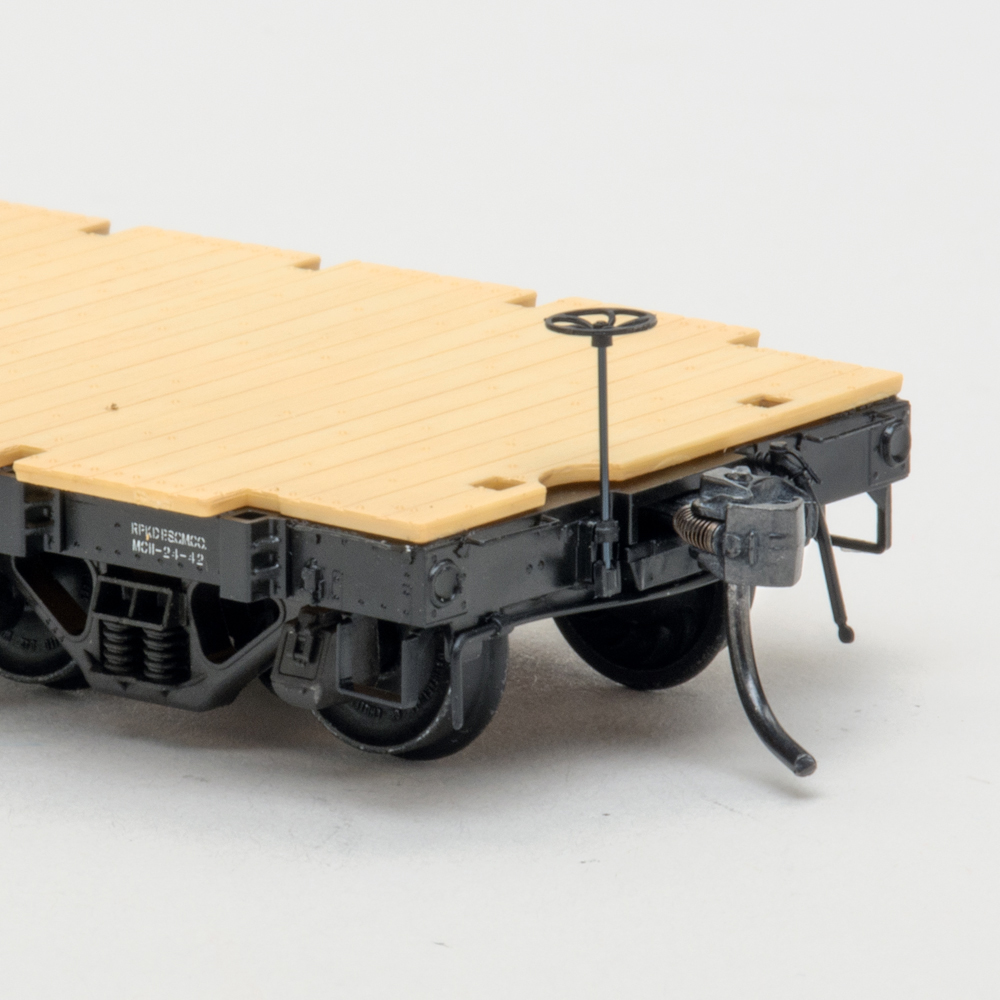Screaming into the station with the realistic sound of its head-end-power (HEP) equipped prototype, the Rapido F40PH models a locomotive that dominated North American rail travel for more than three decades. The Rapido Trains model is also the first to be available correctly detailed for the Canadian-specific F40PH-2D version. We tested an F40PH-2D that came factory-equipped with a dual-mode ESU LokSound Select decoder that delivered realistic sound and prototypical performance.
The VIA Rail Canada version is sold out at Rapido but is available from some of its Canadian dealers as well as the secondary market. Rapido has announced a prototype-specific Amtrak F40PH version that will be available in late 2015.
The prototype. First delivered in 1976, the General Motors Electro-Motive Division F40PH soon became the primary passenger diesel-electric locomotive for Amtrak. Between 1986 and 1989 General Motors Diesel Division in London, Ont. built the F40PH-2D to the same basic design with numerous detail differences
General Motors based the F40PH on its GP40-2. Equipped with a 3,000 or 3,200 hp 16-cylinder 645E3 prime mover, the F40PH and its variants featured a cowl body and high-speed trucks.
A HEP alternator provided heat, air conditioning, and light to the train. The prime mover had to remain at full throttle for the alternator to function. When HEP was engaged, the engineer’s throttle controlled locomotive speed by varying the current to the traction motors. The throttle had no effect on the prime mover.
Several of the Amtrak F40PH locomotives remain in service today as non-power control unit cab cars. From 2006 to 2012, 54 of VIA’s F40PH-2D fleet were rebuilt and remain in service.
The model. The model’s dimensions match an F40PH prototype drawing in the April 1987 Model Railroader.
Our F40PH-2D is accurately detailed and painted according to VIA prototype photos with legible printing and sharp separation lines between colors. The model captures all the prototype’s spotting features. These include the passenger-style pilot (no snowplow), center-mounted fuel tank, side door position (farther rearward), and a winterization hatch above the forward-most radiator fan.
All grab irons, lift rings, wind deflectors, windshield wipers, and horn are separate plastic parts. The radiator fan grills and side air intake screens are separate etched-metal parts.
Our review sample models a prototype with some additional modifications, including a cab roof-mounted air conditioner and bug shields across the top of the nose.
The high level of prototype-specific detail extends to the cab interior, including three painted crew seats and a desktop control stand (the “D” in the F40PH-2D designation). No figures are included, so a modeler who wishes to add them will need to remove the locomotive shell.
The mechanism. After removing the coupler boxes, I used wood toothpicks to carefully spread the sides of the locomotive body shell, then lifted it off the die-cast metal locomotive chassis. The motor and brass flywheel are in the center of the chassis. Two universal shafts transfer power to the truck-mounted gearboxes.
The main printed-circuit (PC) board is mounted to the weight above the mechanism. The ESU LokSound Select decoder plugs into the main PC board via a 21-pin socket.
The oblong speaker enclosures are similar to those used in MP3 music players. Although each enclosure is only 3⁄16″ thick, the sound remained clear at full volume.
Light-emitting diodes and plastic light pipes illuminate the headlight, number boards, marker lights, rear light, and ditch lights.
DCC performance. In speed step 1 the model rolled smoothly at less than 1 scale mph. Its top speed was 60 mph, which is more than fast enough for relatively short model railroad main lines. A prototype F40PH-2D is geared for a top speed of 95 mph, while the Amtrak F40PH fleet was geared for 110 mph.
The decoder’s back-electromotive- force (BEMF) control kept the speed constant regardless of the grade or load. The locomotive should have no trouble hauling a typical VIA passenger consist, as its 4.3-ounce drawbar pull is equivalent to 20 free-rolling HO passenger cars on straight and level track.
Prototypical sound. The model’s rendition of the EMD turbocharged 645E3 sounds spot on, especially the HEP operation. This effect also adds another level of operating fun to the model.
Functions 4 and 5 toggle the locomotive between three HEP modes. In “idle,” the HEP alternator isn’t engaged, so the prime mover sounds like a freight engine ramping up or down according to the throttle setting. In “run” mode, the HEP alternator is engaged, so the prime mover is in notch 8 regardless of the throttle setting or locomotive speed. When the locomotive sits with a train in the station for an extended period, it’s set to “standby” mode where the HEP alternator is engaged but the prime mover drops down to notch 6. In “standby” the throttle didn’t have any effect, until I pressed function 5 to set the HEP to the “run” mode. For those that don’t want this sort of manual control, the instruction booklet describes how to disable the feature.
Following prototype practice, the headlight and rear light aren’t directional. Instead, function 12 turns on switching mode, which sets the front and rear headlights to dim for yard operation.
To follow Rule 17 during road operation, I used function 7 to dim the headlight when approaching a station or another locomotive. Function 6 turns the ditch lights on or off. Function 10 controls the red markers. These lights are used when the locomotive is the trailing unit in push-pull operations. The class lights next to the markers are non-functioning.
The default horn is the correct Nathan K3L, but Nathan K3LA and P5A sounds are also available. As per VIA practice, the bell sounds when the horn is blown and can be triggered independently. Other user-triggered effects include a grade-crossing signal with Doppler effect, dynamic brake fans, and Sarco “spitter” valves. All the functions can be remapped to other keys.
Most of the sound, light, and performance features can be adjusted using configuration variables (CVs). This includes adjusting individual sound-effect volume levels using CVs that are listed in the printed instruction manual.
The decoder supports CVs 19, 21, and 22 for advance consisting and consist function control. I easily advance-consisted a pair of F40PH-2Ds for push- pull operation on our HO scale layout. Extensive programming information is provided in a free ESU user manual available on the Rapido Trains website.
DC operation. The ESU dual-mode decoder also provided exceptional speed control on our DC test track. I advanced the throttle to 6.5 volts, and the locomotive crept along at less than 1 scale mph. The mechanism was smooth throughout its speed range up to a top speed of 60 scale mph at 12V.
The sounds and headlight turned on at 6V, but as noted in the instructions, the backup light doesn’t function in DC. The prime mover stays in notch 8, as if the HEP switch is set to run. I appreciated that the prime mover sounds remained constant when I flipped the power pack’s direction switch. The only sound effect
I had control over were the squealing brakes, which triggered when I quickly decreased the throttle. An analog sound controller, such as an MRC Tech 6, is required to access the other sound functions during DC operation.
The prototype-specific sound and operation really brought this museum-quality model to life. For those modeling Canadian (and soon Amtrak) passenger operations, the F40PH-2D is worth a look and a listen.
Amtrak F40PH: $299.95 (DCC sound), $199.95 (DC, no sound).
Manufacturer
Rapido Trains
500 Alden Rd., Unit 14
Markham, Ont., Canada L3R 5H5
www.rapidotrains.com
Era: 1998 to 2012 (VIA Rail, as detailed and decorated)
Road names (multiple road numbers): VIA “Canada” and 1986-2000 as delivered scheme.
Amtrak F40PH available in phase 2 (1976 to 1980s) and phase 3 (1979 to 1990s). Undecorated version also available.
Features
▪▪All-wheel drive and electrical pickup
▪▪Dual-mode ESU LokSound Select sound decoder (DCC version only)
▪▪Five-pole skew-wound motor with brass flywheels
▪▪Macdonald-Cartier metal knuckle couplers at correct height
▪▪Metal RP-25 wheels in gauge
▪▪Weight: 1 pound 0.2 ounce





